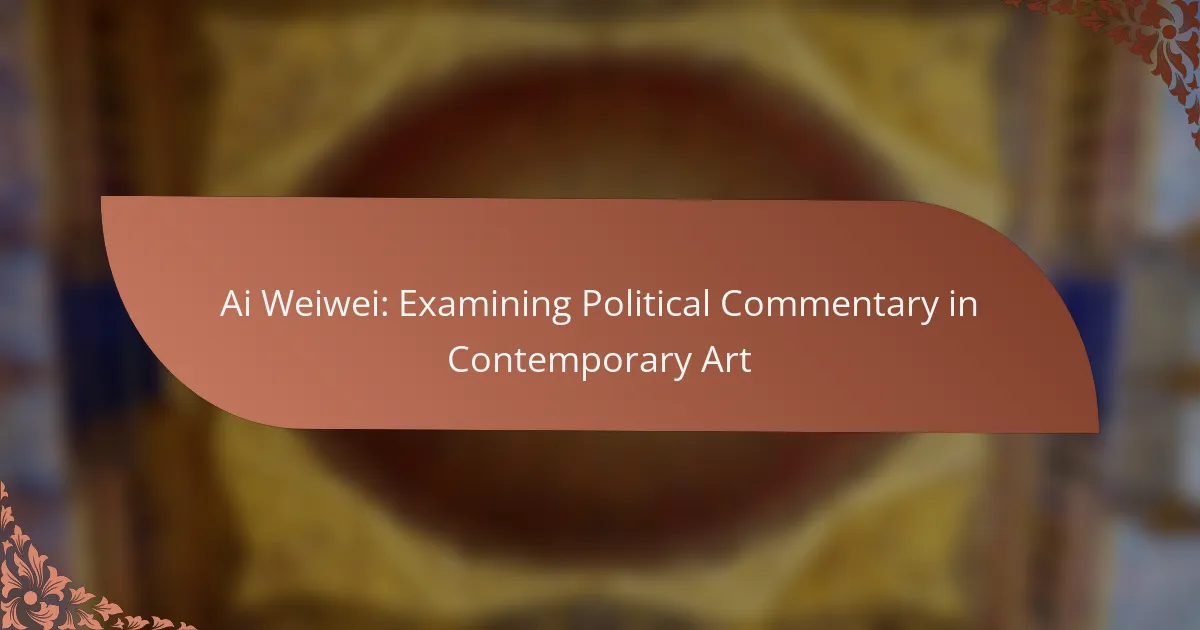Ai Weiwei’s art serves as a powerful vehicle for political commentary, addressing themes of freedom, human rights, and social justice. His unique background shapes his critique of authoritarianism, utilizing diverse mediums like installation art and photography. Through collaborations with fellow artists and activists, he amplifies messages of resistance against oppression. Ai Weiwei’s work fosters critical dialogue on censorship and the role of art in social change.
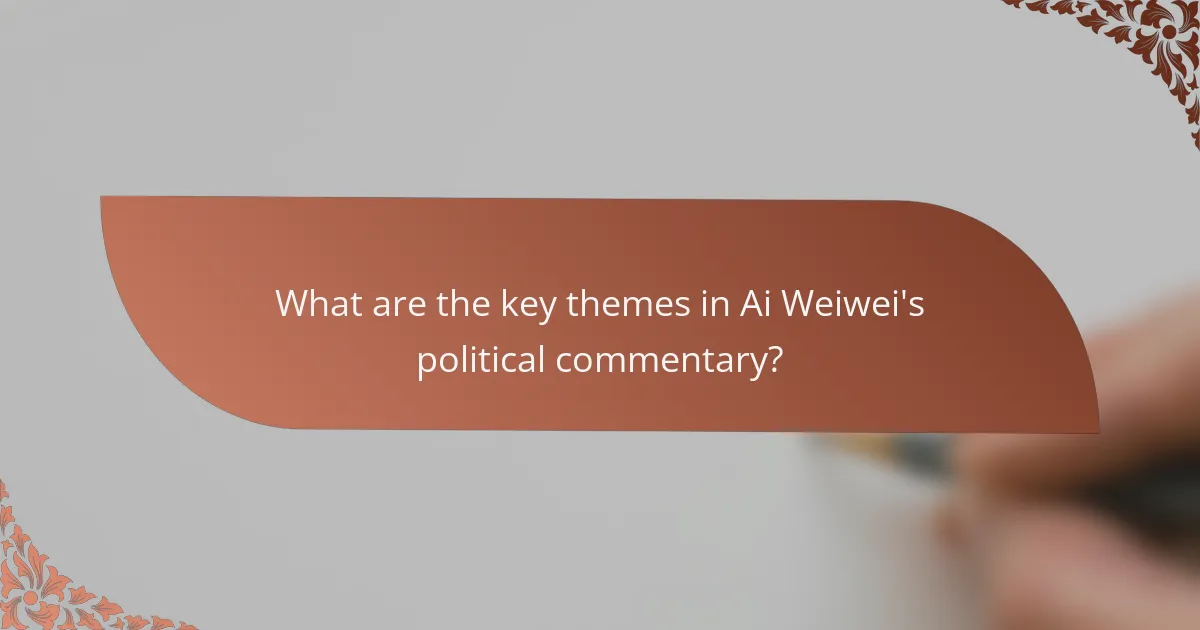
What are the key themes in Ai Weiwei’s political commentary?
Ai Weiwei’s political commentary emphasizes themes of freedom, human rights, and social justice. His art critiques authoritarianism and advocates for marginalised voices. Notably, he uses installation art and social media to amplify these messages. His unique approach combines personal experiences with global issues, making his commentary both relatable and impactful.
How does Ai Weiwei utilize symbolism in his art?
Ai Weiwei employs symbolism in his art to convey political messages and critique societal issues. His works often incorporate materials and forms that resonate with historical and cultural narratives. For instance, he uses traditional Chinese artefacts to challenge contemporary political realities. The use of symbolism allows him to engage viewers on multiple levels, prompting reflection on themes like freedom, oppression, and human rights. His installations, such as “Sunflower Seeds,” symbolise mass production and individualism, illustrating the tension between collective and personal identity. Through these layers of meaning, Ai Weiwei’s art becomes a powerful tool for social commentary.
What role does social media play in Ai Weiwei’s activism?
Social media amplifies Ai Weiwei’s activism by providing a platform for immediate political commentary and global outreach. Through platforms like Twitter and Instagram, he shares his art and messages, engaging a wide audience. This accessibility allows for rapid dissemination of his views on human rights and freedom of expression. Social media also facilitates interaction with followers, fostering a community around his causes. His unique approach combines visual art with digital activism, making his work resonate across borders and cultures.
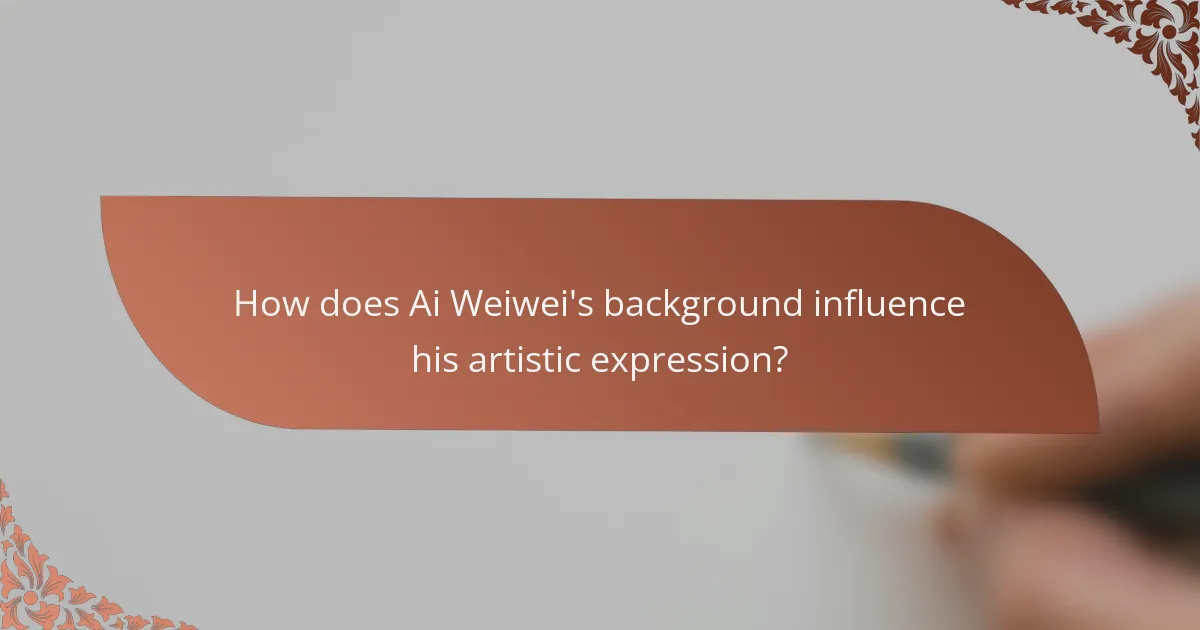
How does Ai Weiwei’s background influence his artistic expression?
Ai Weiwei’s background profoundly shapes his artistic expression, infusing it with political and social commentary. His experiences in China, particularly with government oppression, influence themes of freedom and human rights in his work. Growing up during the Cultural Revolution exposed him to censorship and state control, which he critiques through various mediums. His unique perspective as a global artist allows him to address universal issues while remaining rooted in his cultural heritage.
Which personal experiences shape his perspective on freedom and human rights?
Ai Weiwei’s perspective on freedom and human rights is shaped by his experiences of oppression and exile. His childhood in China during the Cultural Revolution instilled a deep understanding of censorship and state control. As a result, his art serves as a powerful critique of authoritarianism. His activism, including his detention in 2011, highlights the risks faced by those advocating for human rights. This unique combination of personal and political experiences informs his artistic expression and commentary on global human rights issues.
How does Ai Weiwei’s cultural heritage inform his work?
Ai Weiwei’s cultural heritage profoundly influences his work, infusing it with historical and social commentary. His Chinese background shapes his perspectives on authority, freedom, and identity. For example, his installations often reference traditional Chinese art forms while critiquing contemporary political issues. This blend of heritage and modernity creates a unique narrative that challenges viewers to reflect on cultural and political dynamics. Ai’s art serves as a bridge between past and present, highlighting the impact of history on current social conditions.
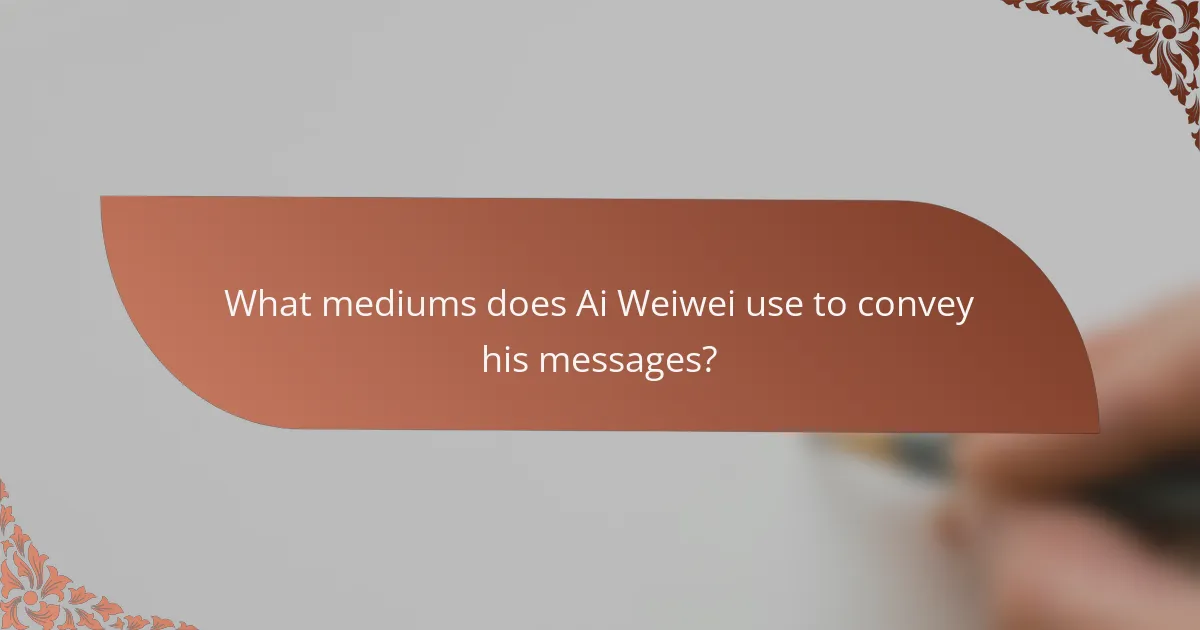
What mediums does Ai Weiwei use to convey his messages?
Ai Weiwei uses various mediums including sculpture, installation, photography, and film to convey his messages. His works often challenge political and social issues, employing materials like porcelain and wood. For example, his installation “Sunflower Seeds” consists of millions of handcrafted porcelain seeds, symbolising mass production and individualism. Through these mediums, Ai Weiwei effectively critiques authority and promotes human rights awareness.
How does installation art serve as a platform for political discourse?
Installation art serves as a powerful platform for political discourse by engaging audiences in immersive experiences that provoke thought and dialogue. Ai Weiwei exemplifies this approach, using his art to challenge authority and address social issues. His installations often incorporate materials and symbols that resonate with contemporary political struggles, enhancing the emotional and intellectual impact on viewers. By transforming spaces into sites of reflection, installation art fosters a deeper understanding of complex political narratives, encouraging public engagement and activism.
What is the significance of photography in Ai Weiwei’s narrative?
Photography plays a crucial role in Ai Weiwei’s narrative by documenting social injustices and political dissent. His work often uses visual imagery to challenge authority and provoke thought. Through photography, Ai Weiwei captures the human experience, emphasizing themes of freedom and oppression. This medium allows him to create a dialogue around contemporary issues, making his political commentary accessible and impactful.
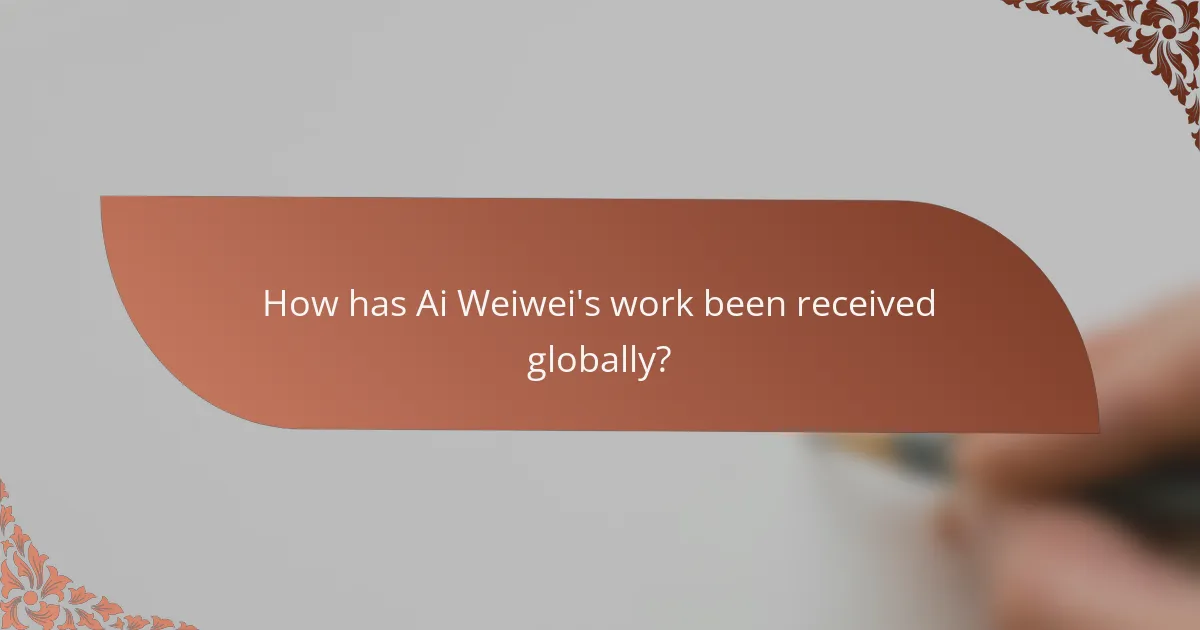
How has Ai Weiwei’s work been received globally?
Ai Weiwei’s work has received widespread acclaim and criticism globally, reflecting diverse interpretations. His art often sparks dialogue on human rights, freedom of expression, and political dissent. Critics appreciate his ability to blend aesthetics with activism, while some governments view his work as provocative. Exhibitions worldwide, such as in the Tate Modern and the Venice Biennale, have solidified his status as a leading contemporary artist. Public reception varies, with supporters praising his courage and detractors questioning his methods. Overall, Ai Weiwei’s impact on contemporary art is significant, engaging audiences in critical political discourse.
Which exhibitions have had the most impact on public awareness?
Ai Weiwei’s exhibitions have significantly raised public awareness of political issues. Notable examples include “Sunflower Seeds” at the Tate Modern and “Good Fences Make Good Neighbors” in New York City. These works engage audiences with themes of freedom, censorship, and human rights. The impactful nature of Ai Weiwei’s art often leads to discussions that extend beyond the gallery walls, influencing public discourse and activism.
How do different cultures interpret his political messages?
Different cultures interpret Ai Weiwei’s political messages through diverse lenses shaped by historical, social, and artistic contexts. For instance, in Western cultures, his work often emphasizes human rights and freedom of expression, resonating with audiences familiar with democratic ideals. In contrast, Asian cultures may focus on his critiques of authoritarianism, reflecting their own experiences with political repression.
Moreover, the medium of his art—whether installations, social media, or public protests—affects interpretations. In some cultures, his use of traditional materials symbolizes a connection to heritage, while in others, it highlights the clash between modernity and tradition.
The global reach of his work fosters dialogue among cultures, enabling a shared understanding of universal themes like justice and resistance. As a result, Ai Weiwei’s political commentary transcends cultural boundaries, inviting varied responses that enrich the discourse around contemporary art and activism.
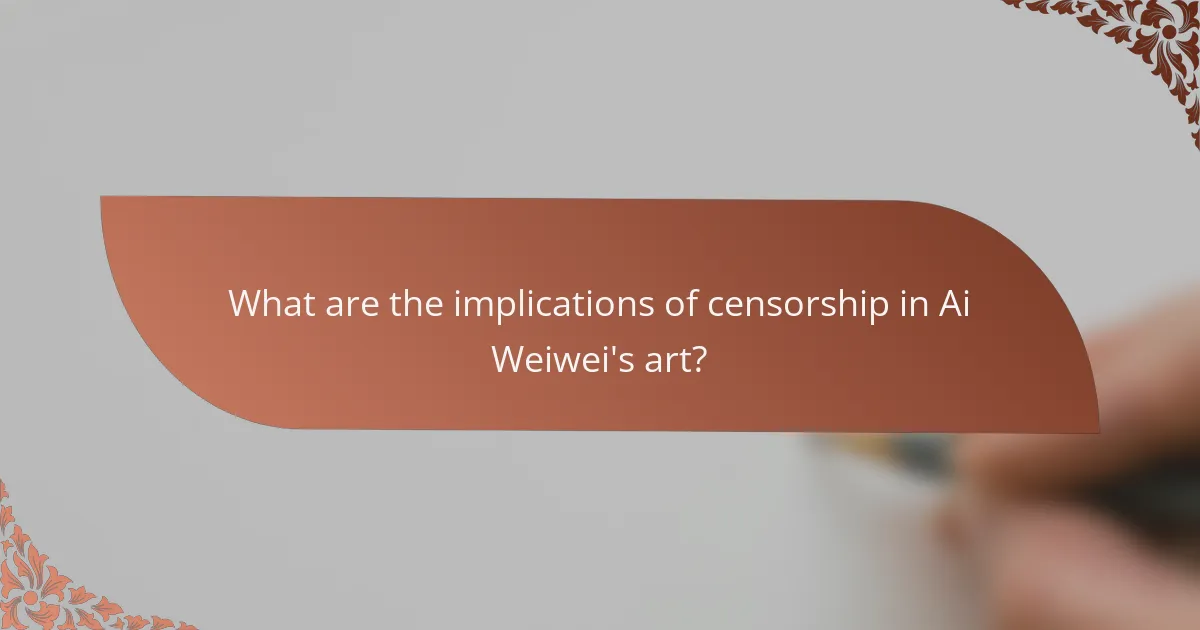
What are the implications of censorship in Ai Weiwei’s art?
Censorship significantly impacts Ai Weiwei’s art by limiting freedom of expression. It shapes his work as a response to oppressive regimes, highlighting the struggle for human rights. Through art, Ai Weiwei critiques government actions, fostering dialogue on censorship’s consequences. His unique approach transforms personal experiences into universal statements, making his art a powerful political commentary.
How does Ai Weiwei respond to government repression?
Ai Weiwei responds to government repression through provocative art and activism. His works often critique authoritarianism and advocate for human rights. For instance, his installation “Sunflower Seeds” symbolizes mass production and individualism, highlighting social issues. Additionally, Ai employs social media to amplify his message, engaging a global audience. His unique ability to blend art with political commentary makes him a prominent figure in contemporary discourse on freedom and expression.
What are the consequences of his outspoken political stance?
Ai Weiwei’s outspoken political stance has led to significant consequences, including government scrutiny and international acclaim. His art often critiques authoritarian regimes, resulting in censorship and personal risk. As a result, Ai Weiwei has become a symbol of resistance, inspiring global conversations about freedom of expression. His unique approach to art and activism has elevated his status, making him a pivotal figure in contemporary political discourse.
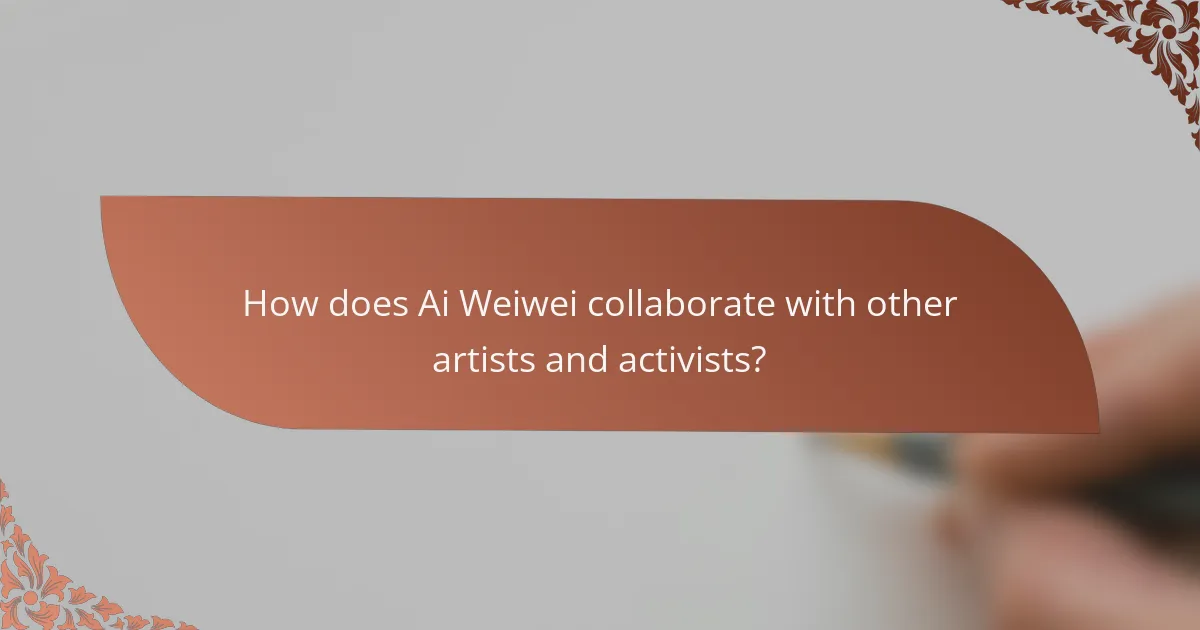
How does Ai Weiwei collaborate with other artists and activists?
Ai Weiwei collaborates with artists and activists to amplify social and political messages. His partnerships often focus on human rights, freedom of expression, and cultural critique. For example, Ai has worked with international artists like Olafur Eliasson and activists such as the Syrian artist Tammam Azzam. These collaborations create impactful installations and public artworks that challenge oppressive regimes. Ai’s unique approach merges diverse perspectives, fostering a global dialogue on pressing issues. Additionally, his involvement in collective projects, like the “Sunflower Seeds” installation, exemplifies how collaboration can engage audiences and provoke thought.
Which partnerships have amplified his political commentary?
Collaborations with influential artists and organizations have significantly enhanced Ai Weiwei’s political commentary. Partnerships with Amnesty International and his involvement in the “Sunflower Seeds” installation at Tate Modern exemplify this impact. These alliances amplify his messages on human rights and freedom of expression, showcasing art as a powerful medium for political discourse.
How do collective projects enhance the impact of his work?
Collective projects significantly amplify Ai Weiwei’s political commentary by fostering collaboration and broadening audience engagement. These initiatives unite diverse voices, enhancing the social relevance of his work. For example, his involvement in large-scale installations allows for communal participation, which deepens the impact of his messages on human rights and freedom of expression. By integrating various artistic disciplines, these projects create a multifaceted dialogue that resonates more powerfully with viewers. This collaborative approach also highlights the unique attribute of community-driven art, reinforcing the urgency of political issues in contemporary society.

What lessons can be learned from Ai Weiwei’s approach to political art?
Ai Weiwei’s approach to political art teaches the importance of activism, personal narrative, and global awareness. His work emphasizes the power of art as a medium for social change. By blending personal experiences with broader political themes, he engages audiences effectively. His unique ability to provoke thought and inspire action through art highlights the role of artists in society.
What best practices can emerging artists adopt from his strategies?
Emerging artists can adopt Ai Weiwei’s strategies by embracing activism, utilising social media, and fostering collaboration. His work highlights the importance of engaging with political issues, which can amplify an artist’s message. Social media serves as a powerful tool for outreach, enabling artists to connect with a global audience and share their perspectives. Additionally, collaboration with other artists and communities can enhance creativity and impact.
What common pitfalls should artists avoid when tackling political themes?
Artists should avoid oversimplifying complex issues, relying on clichés, and alienating audiences. These pitfalls can dilute the intended message. Engaging with political themes requires nuanced understanding and authenticity. For example, Ai Weiwei emphasizes personal experience and cultural context, which enhances his commentary. Balancing artistic expression with social critique is essential to resonate effectively.
